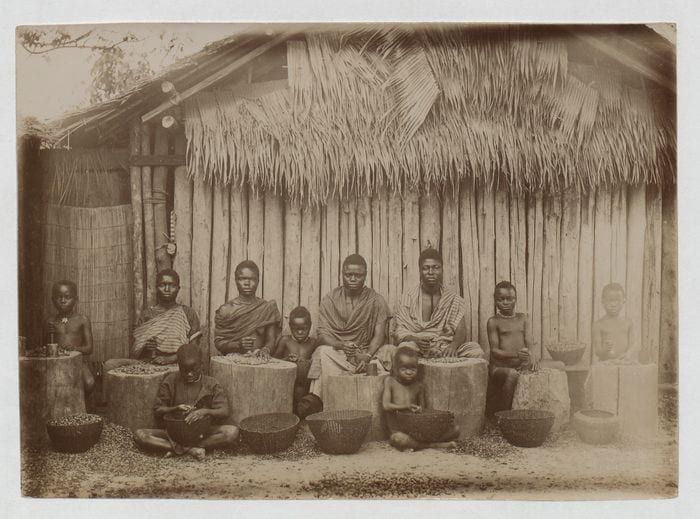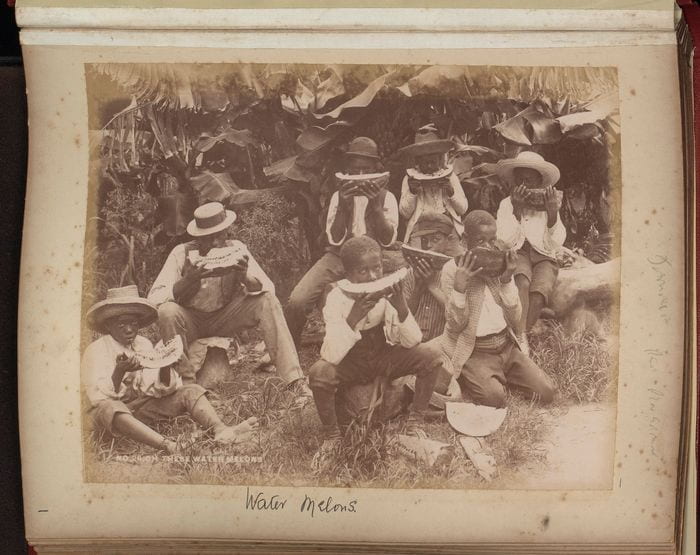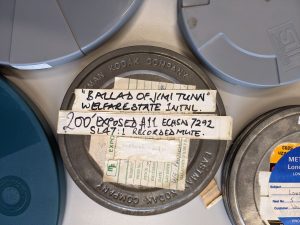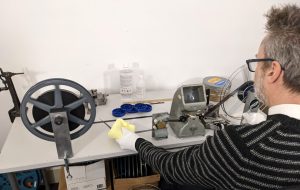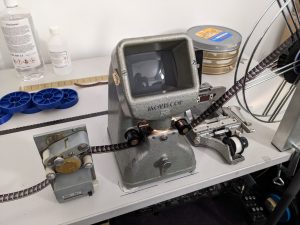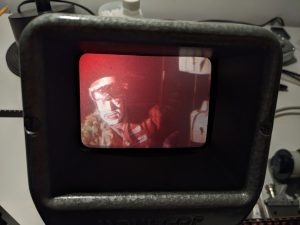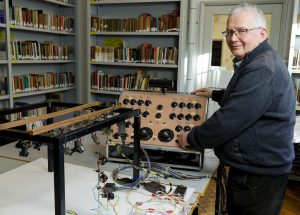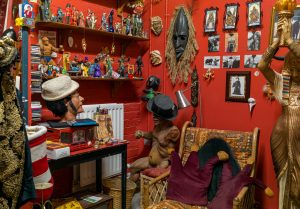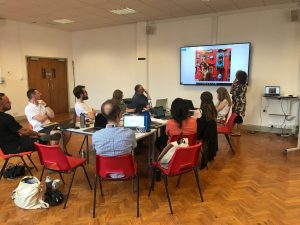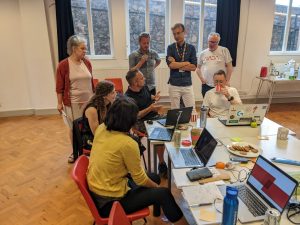Polly Tisdall, the current recipient of the Kevin Elyot Award, is publishing an audio diary as part of her residency at the Theatre Collection as she explores the Kevin Elyot archive and her own writing practice. The annual award established in 2016, generously funded by an endowment from members of Kevin’s family, supports a writer-in-residence at the Theatre Collection to inspire a new dramatic work or other creative or academic outcome. It is given in memory of Kevin Elyot (1951-2014) – an alumnus of the University of Bristol Drama Department – and the influence he has had on writing and the Arts.
Polly’s audio diary is available to listen to here: ‘Kevin Elyot, Crop Circles & Me’ or via Polly’s website with new episodes being published throughout her residency. We’ll also post episodes on our blog page with transcripts, with the first episode available below:
Speaker 1 (Polly Tisdall):
Bristol City centre. Just got off the bus, after wending my way through Fishponds and Eastville and St Pauls and just loving all the colourful leaves. This is my favourite time of year and I’ve got that kind of sense of beginnings, I suppose that I get still, like a new school year.
I still get that at this time of year and it feels a bit like a first day at a new school, and I’m just winding my way up Orchard Lane and thinking this maybe isn’t the quickest way to the Theatre Collection, but never mind.
Going on a little adventure.
Found the many, many, many steps past Trenchard Street car park. I remember this.
This is the route, the very steep, huffy, puffy route up to the Theatre Collection. At least it’s the one that I know. I have come up this way before.
And there’s something about coming through Bristol this morning with my mind half in the play that I’ve pitched for the Kevin Elyot Award that I’m going to be writing (Ahhh!) in the next year. And having that in mind and thinking through one of the characters I’m interested in potentially exploring in the play, it’s all very early days.
But I think trying to see the city a little bit through her eyes and imagining some of her impressions of Bristol if she was coming here for the first time, which, I think for that character she lives very rurally. I don’t think she gets to the city much and Bristol’s kind of her big, big city on the horizon.
Quite interesting to think about, even though I know the city really well these days, what she would make of my morning and the route I’ve been on and all these steps.
- And I’m here! ‘Theatre Collection, Archive and Museum of British Theatre and Live Art, Visitors Welcome, Admission Free, University of Bristol’.
And for those of you who maybe have never been here or don’t even know quite where it is, it’s not far from Park Street. And it’s a sort of a quite amazing building, with a rounded front and, sort of, I guess you would call them crenellations along the front. So it looks a bit castle-like, a little bit magical and it’s time to step inside.
So inside you come into a big panelled room, you can probably hear it’s a little bit echoey and quite exciting and someone’s coming down the stairs to greet me….
Speaker 2:
Welcome to the Theatre collection. We have your items for you, if you’d like to follow me.
Speaker 1:
Thank you.
———
Speaker 1:
Wow. So it’s been quite a fascinating morning.
I’m now standing just outside the reading room of the archive, just having a quick cup of coffee and refreshments because no food or drink is allowed in the reading room itself, with the materials from the archive, which is understandable.
And just reflecting on my first foray into the Kevin Elyot Archive. I asked for a lot of different materials really for my first day, mostly around My Night with Reg, which is one of Elyot’s most famous plays and I definitely asked for too many things!
I’ve got 4 big boxes. Blue boxes of materials around My Night with Reg, all sorts of notebooks and planning from Kevin as well as different scripts and drafts and also some screenplays from when My Night With Reg became a film. And each folder is just beautifully organised and wrapped up with, like, sort of canvas ribbon which might be very, very familiar to people who work in archives a lot. But this is all quite new to me and quite exciting.
And it feels a little bit like being given some gifts and treasures from Kevin’s work and his process.
And really today I’ve just looked in detail at two of his notebooks of his very early starting point ideas that become the play My Night With Reg.
But what’s fascinating looking through the notebooks is seeing that actually a lot of the ideas that surface in My Night With Reg start their life in other plays, in other ideas for other plays, for short sequels or sketches.
And they’re all just jotted down. And these themes keep popping up and reoccurring.
Some ideas that Elyot clearly didn’t want to lose, and he’s written notes to himself. Like ‘Don’t forget the tomato sauce theme’.
And it’s really reassuring and exciting to see, as I suppose somebody who is right at the beginning of their journey with playwriting. Because I’m thinking I’ve got notebooks strewn with some of those sorts of notes and not as detailed as Kevin’s, and certainly not as many notebooks. Not yet. But there’s a familiarity to me in seeing those process notes to yourself and all these questions he’s asking of himself and of his characters and of his ideas. There’s lots of question marks in brackets.
And I think that’s something that really strikes me about the process of playwriting. Certainly for me, where I’m at right now with thinking about the play that I’ve pitched for this award that’s in its extreme infancy. And also, I suppose as you go through a process: that you’re always in conversation with yourself.
A little bit like I am in this audio diary. You’re always in conversation with yourself.
Asking yourself things, bucking yourself up. There’s some really encouraging notes that Kevin has written to himself where you can see there’s been a burst of enthusiasm about the project and he’s written:
Oh! ‘My Night with Reg could be a real event. I just need to write a really good play’. And find the right set of characters and there’s like 3 exclamation marks. And that burst of energy feels familiar to me too, as a creative.
The moments when you get really behind yourself and really fired up and then other moments where you start to lose the plot and wonder if you have anything to say at all.
And that also came up in these notebooks. At one point, Elyot had scribbled down an idea for a play that was about a writer who actually had absolutely nothing to say.
And wow, that sort of stopped me in my tracks. Because isn’t that every playwright’s greatest fear that actually, we have nothing of interest to say?
So of course we don’t know, but I wonder if Elyot came up with that idea in one of those moments, or reflecting on those moments in the creative process, where you really doubt yourself as well.
———
And that’s it. I’m back outside the Theatre Collection, standing on the chilly streets, looking over at the very lovely Greek bakery. Looks very tempting.
First day of my residency through the Kevin Elyot Award, done!
Those questions that Elyot asked himself. All of these question marks at the end of sentences and what ifs. I’ve noticed he does a lot of writing out of ‘what if’ kind of paragraphs, of just ‘what if this is the through line?’
‘What if the dishy guy is somebody they never meet?’ Question mark.
Just as he’s scribbling to himself.
And already it’s really made me want to just go and write my own questions of my own characters, my own sort of ‘what if’ paragraphs. So I think that’s what I’m going to do now. I will pop across the road, maybe treat myself to a hot chocolate from the Greek bakery, and do some writing.


